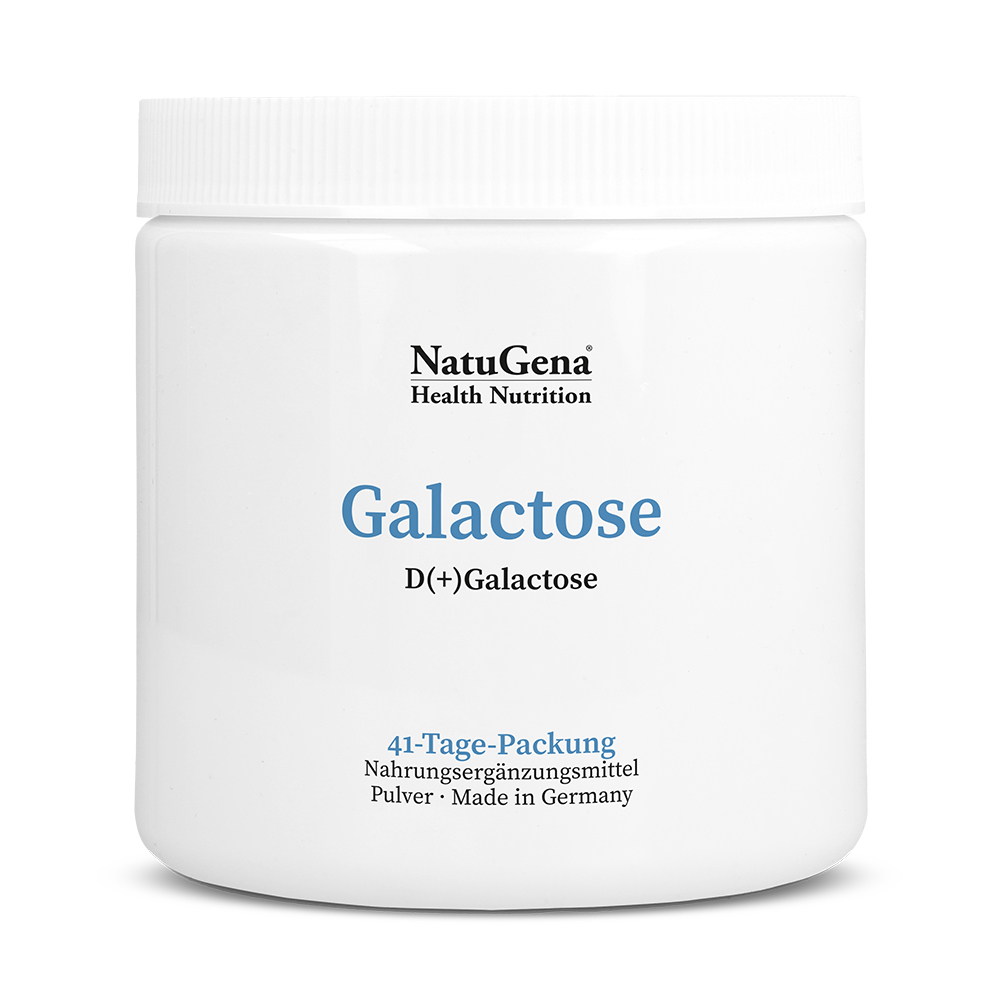Galactose
D(+)Galactose- Galactose ist ein natürlicher Zucker
- schmeckt in etwa nur halb so süß wie Haushaltszucker
- Süßkraft Galactose 40 - 70 % im Vergleich zu Süßkraft Glukose 100 %
- D-(+)-Galactose ist bei Laktoseintolleranz geeignet
- Höchste Rohstoffqualität aus deutscher Herstellung
| Anzahl | Preis |
|---|---|
| ab 1 | 44,95 € |
| ab 3 | 40,95 € |
| ab 5 | 38,95 € |
Lieferzeit 3–5 Werktage. Artikel-Nr.: 2018137
PPN/PZN: 11 18875029 30 (PZN = mittlere Ziffern)
EAN: 4260633571377
Grundpreis: 179,80 € pro Kilogramm
inkl. 7% MwSt., zzgl. Versand Bestellbar
Galactose ist ein natürlich vorkommender Einfachzucker oder Monosaccharid. Es gehört zur Gruppe der Kohlenhydrate und ist strukturell eng mit Glukose verwandt. Er gilt als funktioneller und rein natürlicher Zucker mit guter Verträglichkeit und wird im Körper nur langsam verstoffwechselt.
Sein großer Vorteil ist, dass es durch die konstante Energieversorgung nur zu einem langsamen Anstieg des Blutzuckerspiegels kommt. Die Verstoffwechslung ist kaum von Insulin abhängig.
Der natürliche Zucker Galactose hat verschiedene Funktionen im Körper. Es wird zur Energiegewinnung der Körperzellen und des Gehirns genutzt und ist auch an der Bildung von Glykoproteinen und Glykolipiden beteiligt, welche wichtige strukturelle und funktionelle Rollen in Zellen und Geweben spielen.
Glucose und Galactose gelten als verwandte Zuckerarten. Es unterscheidet sie lediglich die Anordnung einer Hydroxygruppe. Dieser scheinbar kleine Unterschied spielt eine große Rolle bei der Verstoffwechselung in unserem Organismus. Galactose weist somit einen glykämischer Index von 20 auf, wohingegen der GI-Wert der Glukose bei 65 liegt.
Es sind gerade Milchprodukte, welche als Galactoselieferant gelten. Des Weiteren ist es aber auch in Tomaten, Papaya, Datteln, Bananen, fermentiertem Sauerkraut und Hülsenfrüchten vorhanden. Der Stoff ist Bestandteil der Muttermilch und auch für bei Laktoseintoleranz verträglich.
Galactose weist einen dezenten, natürlichen Süßgeschmack auf, der etwa vergleichbar mit dem Geschmack von Traubenzucker ist. Im Vergleich zu herkömmlichen Haushaltszucker (Saccharose: Süßkraft = 100%) liegt ihre Süßkraft bei etwa 45-60 %.
Verzehrempfehlung
Täglich 2-mal 1 gehäufter Teelöffel (1 gehäufter TL=3 g) zwischen den Mahlzeiten mit Tee oder Wasser verzehren. Der Abstand zu einer Mahlzeit sollte mindestens 1 Stunde betragen.
Hinweise
Nahrungsergänzungsmittel sollten nicht als Ersatz für eine ausgewogene und abwechslungsreiche Ernährung sowie für eine gesunde Lebensweise verwendet werden. Außerhalb der Reichweite von kleinen Kindern aufbewahren. Verschlossen, kühl, trocken und lichtgeschützt lagern. Die angegebene empfohlene tägliche Verzehrsmenge darf nicht überschritten werden.
Nicht geeignet für Schwangere und stillende Mütter oder bei Galaktosämie.
Inhaltsstoffe
| Inhaltsstoffe pro | Tagesdosis |
|---|---|
| D(+)Galactose | 6g |
Zusammensetzung
D-(+)-Galactose.
Kein Arzneimittel
Nahrungsergänzungsmittel: Die angegebene empfohlene tägliche Verzehrmenge darf nicht überschritten werden. Kein Ersatz für eine ausgewogene und abwechslungsreiche Ernährung sowie für eine gesunde Lebensweise.
Reinsubstanzen-Prinzip
Nur Wirkstoffe (keine Hilfsstoffe, keine Farbstoffe, laut Gesetz keine Konservierungsstoffe, keine technologischen Zusätze wie Binde- und Trennmittel, keine versteckten Zusatzstoffe, frei von Gluten, Geschmacksverstärkern, Lactose, Aromen, Soja).
Rechtlicher Hinweis
Dieses Produkt dient der Ernährung und berührt deshalb nicht das Heilmittelwerbegesetz (HWG). Ein guter Ernährungsstatus kann dem Organismus helfen Erkrankungen vorzubeugen oder diese zu überwinden. Alle zu dem Produkt getroffenen Aussagen beschreiben Eigenschaften und physiologische Wirkungen, die bei Konsumenten natürlicherweise unterschiedlich ausfallen können, und stellen keine Heil- oder Gesundheitsversprechen dar.
Galactose ist ein natürlich vorkommender Einfachzucker oder Monosaccharid. Es gehört zur Gruppe der Kohlenhydrate und ist strukturell eng mit Glukose verwandt. Er gilt als funktioneller und rein natürlicher Zucker mit guter Verträglichkeit und wird im Körper nur langsam verstoffwechselt.
Sein großer Vorteil ist, dass es durch die konstante Energieversorgung nur zu einem langsamen Anstieg des Blutzuckerspiegels kommt. Die Verstoffwechslung ist kaum von Insulin abhängig.
Der natürliche Zucker Galactose hat verschiedene Funktionen im Körper. Es wird zur Energiegewinnung der Körperzellen und des Gehirns genutzt und ist auch an der Bildung von Glykoproteinen und Glykolipiden beteiligt, welche wichtige strukturelle und funktionelle Rollen in Zellen und Geweben spielen.
Glucose und Galactose gelten als verwandte Zuckerarten. Es unterscheidet sie lediglich die Anordnung einer Hydroxygruppe. Dieser scheinbar kleine Unterschied spielt eine große Rolle bei der Verstoffwechselung in unserem Organismus. Galactose weist somit einen glykämischer Index von 20 auf, wohingegen der GI-Wert der Glukose bei 65 liegt.
Es sind gerade Milchprodukte, welche als Galactoselieferant gelten. Des Weiteren ist es aber auch in Tomaten, Papaya, Datteln, Bananen, fermentiertem Sauerkraut und Hülsenfrüchten vorhanden. Der Stoff ist Bestandteil der Muttermilch und auch für bei Laktoseintoleranz verträglich.
Galactose weist einen dezenten, natürlichen Süßgeschmack auf, der etwa vergleichbar mit dem Geschmack von Traubenzucker ist. Im Vergleich zu herkömmlichen Haushaltszucker (Saccharose: Süßkraft = 100%) liegt ihre Süßkraft bei etwa 45-60 %.
Verzehrempfehlung
Täglich 2-mal 1 gehäufter Teelöffel (1 gehäufter TL=3 g) zwischen den Mahlzeiten mit Tee oder Wasser verzehren. Der Abstand zu einer Mahlzeit sollte mindestens 1 Stunde betragen.
Hinweise
Nahrungsergänzungsmittel sollten nicht als Ersatz für eine ausgewogene und abwechslungsreiche Ernährung sowie für eine gesunde Lebensweise verwendet werden. Außerhalb der Reichweite von kleinen Kindern aufbewahren. Verschlossen, kühl, trocken und lichtgeschützt lagern. Die angegebene empfohlene tägliche Verzehrsmenge darf nicht überschritten werden.
Nicht geeignet für Schwangere und stillende Mütter oder bei Galaktosämie.
Inhaltsstoffe
| Inhaltsstoffe pro | Tagesdosis |
|---|---|
| D(+)Galactose | 6g |
Zusammensetzung
D-(+)-Galactose.
Kein Arzneimittel
Nahrungsergänzungsmittel: Die angegebene empfohlene tägliche Verzehrmenge darf nicht überschritten werden. Kein Ersatz für eine ausgewogene und abwechslungsreiche Ernährung sowie für eine gesunde Lebensweise.
Reinsubstanzen-Prinzip
Nur Wirkstoffe (keine Hilfsstoffe, keine Farbstoffe, laut Gesetz keine Konservierungsstoffe, keine technologischen Zusätze wie Binde- und Trennmittel, keine versteckten Zusatzstoffe, frei von Gluten, Geschmacksverstärkern, Lactose, Aromen, Soja).
Rechtlicher Hinweis
Dieses Produkt dient der Ernährung und berührt deshalb nicht das Heilmittelwerbegesetz (HWG). Ein guter Ernährungsstatus kann dem Organismus helfen Erkrankungen vorzubeugen oder diese zu überwinden. Alle zu dem Produkt getroffenen Aussagen beschreiben Eigenschaften und physiologische Wirkungen, die bei Konsumenten natürlicherweise unterschiedlich ausfallen können, und stellen keine Heil- oder Gesundheitsversprechen dar.
